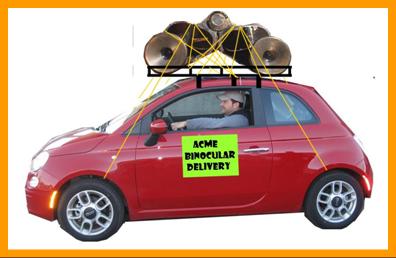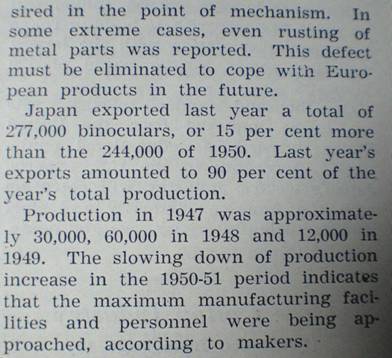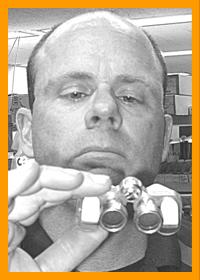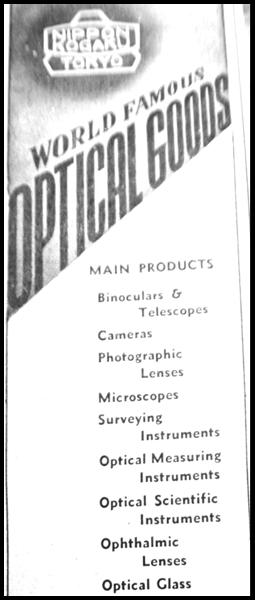

|
Period & Primary Source Documentation ofJapanese Early Post War Binoculars Production. すぐに第二次世界大戦後日本双眼鏡生産, Produktion Ferngläser Nachkriegs.Japan. Production des Jumelles Japonaise après la guerre. 1950- х годов.документации японский бинокли производства. Dokumentation av Japanska Binokulärt Produktion Efter Andra Världskriget Producción de Japonés los Prismáticos en Miniatura Después de la Guerra. Documentazione Primeria do Origine della Produzione do Binocoli Giaponesi Post-Guerra. |

|
[On Binoculars] “Since before the war, Japanese made lenses used to be exported in numbers to Australia and the U.S., where they made a favorable reputation. During the war, domestic demand for binoculars for military use increased phenomenally while export was suspended temporarily. After the war domestic demand has ceased to exist, and nearly all of the current production is shipped abroad.” |
|
[On Binoculars] “Shipments during last year [1950] includes”…” 40,156 6x15 binoculars.” 6x15s binoculars were the most common of the miniature reverse porro prism binoculars, and that power is almost exclusively miniature binoculars of this type. |
|
Japanese External Reverse Porro Prism Binoculars. Binoculars MUSEUM |
|
“There are 22 principal [binocular] makers in Japan.” |
|
Preceding excerpts : Journal of Finance and Commerce, Vol. 4 No. 2 Tokyo Feb. 15, 1951, a Nippon Times Publication,. Library collection of Yale University |

|
1948 Tokyo Advertisement. Goods expositions like this helped link prospective importers and exporters. This is most likely the exact exhibition David Bushnell visited in 1948. Library collection of Yale University |
|
“In Tokyo one building had an exhibition of all the products Japan had available for export, and there were the binoculars. “ David Bushnell, on how he got started in the binoculars business. |
|
Japanese industrial development was known for it’s “SME” (small and medium enterprises) of under 300 employees formed into geographic concentrations of interconnected companies and institutions known as clusters. The International Bank For Reconstruction and development of the World Bank published a study by Hideki Yamawaki, entitled The Evolution and Structure of Industrial Clusters in Japan. Yamawaki identifies Itabahi (Tokyo) as an industrial cluster for binoculars, and notes that “During the 1960’s, approximately 95 percent of binoculars sold in the world market were produced in Itabashi, in Tokyo”. He goes on to say “ At the height of its growth in this period, the Itabashi area had around 220 assemblers and 600 related businesses in various stages in the preparation and production of components such as mirrors, lenses and prisms.” |
|
The Role of Industrial Clusters in Japanese Early Post War Binoculars Production. 双眼鏡製造日本 の産業生産クラスタ . Industrielle Gruppen in der Japanischen Fernglas-Fertigung. Groupes Industriels dans la Fabrication Japonaise de Jumelles. промышленных групп в японском изготовления бинокль. El Papel de los Clusters Industriales en Japonés Prismáticos Producción Después Guerra. Il Ruolo dei Cluster Industriali Nella Produzione do Binocoli Giapponesi Post-Guerra. |

|
Binocular Advertisement, Tokyo Kokaku Kikai K.K, Journal of Finance & Commerce,1951, A Nippon Times Publication Library of Yale University |
|
Optical Advertisement, Nippon Kogaku K.K, Journal of Finance and Commerce,1953, A Nippon Times Publication , Library collection of Yale University |
|
Journal of Finance and Commerce,1953, A Nippon Times Publication, Library collection of Yale University |
|
Binoculars and cameras were not the only promising exports to the US in the early 1950’s! US DEMAND FOR EDIBLE FROG MEAT made it a Dollar Export Standout and the insatiable U.S. hunger for edible frog meat (700 tons shipped from Japan to the US in 1950), led to frog shortages and an export drop in Japan in 1952 and further tonnage decreases for 1953, leading to imposition of frog hunting seasons, minimum size for keepers, and emergency frog breeding programs ! |
|
Japanese Binocular Production 1951-1953 (all types), Per binocular branch of the Optical Precision Machinery Association Journal of Finance and Commerce,1953 A Nippon Times Publication, Library collection of Yale University |
|
Journal of Finance and Commerce,1952, A Nippon Times Publication, Library collection of Yale University |





|
Feb. 1953 Miniature Binocular Production Figures, 6x15 and 7x18 powers Japanese Binocular Production Per Binocular Branch of the Optical Precision Machinery Association, Journal of Finance and Commerce,1953, A Nippon Times Publication, Library collection of Yale University |


|
A Glimpse Into Details of Japanese Binocular Importation into the USA. 日本双眼鏡 インポートの詳細については、米国に . Fernglas-Einfuhr in Die US von Japan. Importation de Jumelles . Japonaises aux Etats Unis. Бинокли импорт в США: как это работало. Importera Japanska Kikare i USA. Prismáticos Japoneses Importación a Estados Unidos Una Squardo ai Dettagli Dell’importazione doBinocoli Giapponesi Negli Stati Uniti. |
|
A case of the United States Customs Court, Second Division, offers interesting insights into the nuts and bolts of importing binoculars from Japan into the United States, and the role of various entities. The case was Bushnell International Inc, Appellant, versus the United States, Appellee, Sept 16. 1971. Some edited excerpts follow. The record consists of the testimony of David P. Bushnell, president of Bushnell International, Inc., the importer herein, and a number of documentary exhibits. From the evidence, it appeared that Bushnell has been importing optical goods from Japan since 1948, and that in 1950 the Oriental Trading Company, Ltd., was appointed Bushnell’s buying agent. A written agreement was entered into in 1955, according to which Oriental Trading was "to handle all the details concerning purchase of merchandise from factories on ex-factory basis, inspection at the Laboratory, export packing, storage, transportation to the port of shipment and shipping documentation" for which it was to receive a 5 percent commission on the ex-factory value of the merchandise... The Japanese name of Oriental Trading Company, Ltd., is Toyo Jitsugyo KK. The firm was formed in 1947 to serve as a buying agent. In 1956 it set up a factory branch at Kugahara, Japan. The Kugahara factory is registered as a manufacturer of binoculars and is referred to by the Japanese name of Toyo Jitsugyo KK. Oriental Trading Company, Ltd., is registered as an exporter and has retained its English name. However, Toyo Jitsugyo KK and Oriental Trading Company, Ltd., are not two separate companies; Oriental Trading is merely the export division of Toyo Jitsugyo KK. Mr. Bushnell testified that he first became acquainted with the Toyo Jitsugyo Kugahara factory in 1956 when he was taken there on a visit to Japan. He understood that there were some common stockholders in Toyo Jitsugyo and Oriental Trading, but that in order to build a factory, additional capital was needed and other stockholders were brought in. He did not ask anyone about the specific relationship as he was interested only in getting good quality binoculars at a reasonable price. He did not learn that the Kugahara factory and Oriental Trading were related until 1966. In fact, in 1960, the working relationship between Bushnell and Oriental Trading was confirmed by a written agreement, which stated, among other things: As our purchasing agent, you are to handle all of the details concerning the purchase of the merchandise we designate from the various factories that you deem most appropriate under the circumstances. Purchases are to be made on a freely offered ex-factory basis. You are to inspect every item to assure yourselves that each meets our high standards of quality. You are to supervise the export packing, arrange for outside storage and subsequent transportation to the port of export. You will pay all charges between the factory and port of exportation. You are to prepare all export documentation. All of your expenses, plus two percent (2%) for inspection fee and your five percent (5%) buying commission, are to be shown separately from the maker’s ex-factory prices for the merchandise. Your charges and the makers charges are to be shown on your invoices to us and collection made under our Letter of Credit in your favor. Mr. Bushnell negotiated with the Kugahara factory in the same manner as he dealt with other manufacturers at ex-factory prices. Sometimes a representative of Oriental Trading was present and sometimes not. Oriental Trading performed the same functions of inspection and shipment with respect to the merchandise manufactured by the Kugahara factory as it did with respect to merchandise manufactured by others. |
|
An affidavit of Hideo Machiyama, chief of the Toyo Jitsugyo Kugahara factory states: That Kugahara Factory set the sales price of its merchandise based upon its own determination of costs. That approximately 60% of the production of Kugahara Factory was sold for export to the United States to Bushnell International and was delivered through Oriental Trading Co., Ltd. That Kugahara Factory was not set up to export its merchandise, and purchasers in the United States or in other countries required the services of some export agent to arrange for exportation of his merchandise. That in 1964 and before, the merchandise manufactured by Kugahara Factory was freely offered at the same ex-factory prices for like quantities with similar terms to United States importers through other buying agents. That offers at ex-factory prices such as those attached and marked Exhibit M-4 were also made directly by Kugahara Factory to purchasers from other countries who had export agents in Japan. |
|
Advertisement for the Japanese binoculars exporter, Oriental trading Co, in the Journal of Finance and Commerce, Vol 4 No 2 Tokyo Feb 15, 1951, A Nippon Times Publication. Library collection of Yale University |
|
“Empire Made”, Tariffs, and Japanese Miniature Binoculars in the UK. 英国関税、 イギリス帝国製品 . Die Rolle von Tarifen in der Miniaturferngläser Einfuhr in England. La Rôle des Tarifs dansL'importation des Jumelles Japonaises à l'Angleterre. Роль тарифов на импорт бинокль в Англии. El Papel de los Aranceles en la Importación de Miniatura Prismáticos en Inglaterra. Imperio Fatto, Tariffe, e Binocoli Giapponesi in Miniatura in Inghiltera. |
|
As with most things made for export, and particularly price point items, the imposition of tariffs, duties, taxes and the rate and manner in which they are imposed have always affected binoculars. For example, when explaining the profit in importing binoculars to the US during the 1950’s David Bushnell said “We had to add 20 percent luxury tax, which I didn’t have to pay until the end of the year, so I had that 20 percent capitol to use during the year, plus the profit...We billed the binocular cases separately because that didn’t require luxury tax, and saved the customer a dollar or two.” (According to the Encyclopedia of Taxation and Tax policy, “The World War II and/Korean War luxury taxes were not fully repealed in the United States until 1965.) Likewise, the UK Import Duties Act of 1932 imposed a 10% import tariff on imported manufactured goods, but Imperial Preference generally allowed trade within the Commonwealth tariff free. I believe that “ Empire Made ” markings on vintage optical goods for the UK market indicates Hong Kong manufacture, or Hong Kong assembly, (or Hong Kong packaging) to become “Commonwealth” goods that would avoid the tariff or incur a reduced tariff compared to goods imported into the UK from elsewhere. For example the Regent brand miniature binoculars widely sold in the UK (believed imported by Hadenroy Ltd) are generally marked “ Empire Made ”. While I do not have documentation of exactly what that signified, I believe it is a claim of assembly in the crown colony of Hong Kong (prior to the 1997 transfer to China), presumably with Japanese components. The cases accompanying these Regent binoculars are also usually marked “ made in England” or “Empire made”. Conversely, binoculars and cases imported into the UK from non commonwealth countries were often marked “foreign”. The UK also imposed quotas on binoculars: next section. |


|
These miniature binoculars are occasionally referred to as skeleton binoculars because of a minimal covering of the internal parts. Diese Miniaturferngläser gekennzeichnet gelegentlich als skeleton Ferngläser wegen einer minimalen Bedeckung der internen Teile. Ces jumelles miniatures désigné de temps en temps sous le nom des jumelles squelettiques en raison d'une bâche minimale des pièces internes. Collections of Mark Ohno |


|
The Magnification of Miniature Binoculars ミニチュアの双眼鏡の力, Die Kraft der kleinen Fernglas. La Puissance des Jumelles Miniatures. Ampliación Óptica Prismáticos de Miniatura. L’igrandimento dei Binocoli in Miniatura |
|
The power or magnification and objective diameter encountered on miniature (type) reverse poro prism binoculars of this configuration includes the following (most common in blue). UPDATED 6/26/2019 4x12, 5x15, 5x50, 6x15 , 6x16, 6x17, 6x22, 6x18, 6x20, 6x24, 6x25 , 6x28, 6x30, 7x15, 7x18 , 7x19, 7x20, 7X21, 7x23, 7x24, 7x25 , 7x30, 7x35, 7x40, 8x15, 8x18, 8x20 , 8x21, 8x25, 8x28, 8x30, 9x20, 9x20, 9x21, 10x18, 10x20 , 10x24, 10x25, 10x30 , 10x40 , 12x20, 12x24, 12x25, 12x30, 12x40, 12x50 , 14x50,15x20, 15x25, 15x30, 15x40, 15x50 , 16x50, 18x50 |

|
A Glimpse Into Details of Japanese Binoculars Importation into the UK. Fernglas-Einfuhr in England von Japan. Importation de Jumelles Japonaises à l'Angleterre. Бинокли импорт в Англии: как это работало. Importera Japanska Kikare i Förenade Kungariket. Prismáticos Japoneses Importación en Inglaterra. Una Squardo ai Dettagli Dell’importazione doBinocoli Giapponesi in Inghilterra. |
|
According to Charles G. Strasser, in his book “From Refugee to OBE”, speaking about his UK importation company Photopia, …”we then started importing binoculars from Japan, which became a very big business. Japanese binocular manufacturing was, back then, a cottage industry, even for the most famous makes. Casting the basic aluminum parts is done in one factory, the lenses are ground in another, and the leather covers were made in a third. The exporter—the company putting its brand name on the binoculars—would arrange to collect all these different components and take them into the country where the farming community would assemble them into the finished product. They were then collected, tested, packed and boxed according the brand name they were to be sold under. It turned out to be a very successful business. |
|
UK Import Quotas and Importation Bans Affecting Japanese Binoculars. Quoten Einfuhr und Verbote in das Vereinigte Königreich für die Japanische Fernglas. Importation contingents et interdictions en UK affectant japonais jumelles . Импорт квот и запреты в UK на японский бинокль. Import kvoter och förbud i STORBRITANNIEN Påverkar Japanska Kikare. Importación Contingentes de Importación y Prohibiciones en el Reino Unido Afecta a Japonés Prismáticos. Contingenti Britannici Sulle Importazioni e Divieti di Importazione che Incidono sul Binocolo Giapponese. |
|
I believe that during the 1950’s importing binoculars from Japan into the UK was not permitted, until around 1957, when a quota system for optical goods was established to allow Japanese cameras into the UK. According to the Photopia history the quota affecting photographic equipment (as a subset of optical goods) was lifted in 1962. According to the Economic Weekly of Nov. 1962, the signing of the 6 year Anglo Japanese trade pact in Nov 1962 set quotas for importation of Japanese binoculars into the UK (presumably also encompassing telescopes and monoculars) not to exceed a total value of £60,000 in 1962, not to exceed a total value of £60,000 in 1963, not to exceed a total value of £100,000 in 1964, and not to exceed a total value of £200,000 in 1965. The value of binoculars that were actually imported is unknown, but I saw one estimate that just under £60,000 in Japanese binoculars were imported in 1961 as part of the optical quota. These bans and quotas are presumably why Japanese binoculars from the 1950’s seem quite uncommon in the UK, when people in the UK presumably purchased binoculars from domestic manufactures (Ross, Barr & Stroud, Wray) or acquired the relatively common war surplus binoculars which appear in the catalogs of many UK optical sellers of that time and in their advertisements. |

|
If you have information about importers and distributors of Japanese binoculars in the 1960's-1980's in the UK, Germany Australia, Canada, Sweden, elsewhere in europe please email me at: miniature.binoculars@gmail.com Wenn Sie Informationen über Importeure und Händler von japanischen Fernglas in den 1960er Jahren der 1980er Jahre in Großbritannien, Deutschland Australien, Kanada, Schweden, haben im übrigen Europa wenden Sie sich bitte mailen Sie mir an: miniature.binoculars@gmail.com Si vous avez des informations sur les importateurs et les distributeurs de jumelles japonaises dans les 1960's - 1980 au Royaume-Uni , Allemagne Australie, le Canada , la Suède , ailleurs en Europe s'il vous plaît écrivez-moi à: miniature.binoculars@gmail.com Si usted tiene información sobre los importadores y distribuidores de los prismáticos japoneses en la década de 1960 -1980 en el Reino Unido , Alemania , Australia, Canadá , Suecia, en el resto de Europa por favor envíeme un correo electrónico a: miniature.binoculars@gmail.com |
|
Researching Japanese Companies Involved with Binoculars 67 Years Ago. Erforschung japanischer Unternehmen mit Ferngläsern vor 67 Jahren. À la Recherche d'entreprises Japonaises Impliquées dans des Jumelles il y a 67 ans. 年前 の双眼鏡に関わる日本企業の調査 . Investigando Compañías Japonesas Involucradas con Binoculares hace 67 años. |
|
We have all gotten used to information being a mouse or a screen click away. (And what this website is creating). But that doesn’t apply so well to obscure Japanese companies from 67 years ago that left a minimal paper trail and even smaller digital trail. With really persistent research information can gleaned on some of the manufacturers associated with miniature binoculars, and most of the importers that used their own name. But there are always some names that appear to be company names (not brand names) which appear on a range of binoculars from around the occupation period and just after, but which have proven very difficult to find anything about. “TJK”, “TOR’, and “T.O.M” come to mind. I do know that low profile “trading co” intermediaries acting between the manufacturer and the importer have always been next to invisible. For example the role of O.T.C. / O riental T rading C o. (also known as T.J.K. / T oyo J itsugo K K), who was acting for Bushnell is only illuminated due to testimony in a US Customs court case in 1971, plus an ad in an obscure publication in a non circulating journal in a Yale University library holding. Another example of the value of these obscure Japanese trade journals of the early post war perios is finding TOR in the 1954 Japanasia Japan Trade Directory published by the Japansia Information Service in Toke period yo, and also held in Yale University’s LSF non circulating collection, which lists TOR Optical Trading Co., founded in 1948, as being a manufacturer/exporter/importer of binoculars (microscopes, telescopes, opera glasses and cameras with trade with the USA, Canada, Sweden, Switzerland, and West Germany.) The company was located at 2 Shiba Tamuracho, Minato-Ku Tokyo, with head offices at 2038 Shimoochiai 4-chome, Shijuku-ku, Tokyo and a factory in Tokyo, and a capitalization of 1 million yen |



|
According to Medford (Oregon) Medford Mail newspaper of April 11, 1961, during the year 1948, U.S. commercial entities imported 308 pairs of Japanese binoculars into the United States, and by comparison during the year 1961, 1.8 million pairs of Japanese binoculars were imported into the United States. |
|
Today in most affluent places consumer grade binoculars are considered a casual purchase and a mundane consumer item. As of this writing in 2015 when one uses Google and searches for binoculars on the website of US discounter Walmart®, they are advertising Bushnell® branded Chinese made 8x21 roof prism binoculars at a price of $14.90, or slightly more than 1/2 of an hour’s wage based on the US average hourly wage, and conventional Bushnell® 7x35 porro prism binoculars are advertised for $23.24, or around one hour of US labor. Compare this to Bausch and Lomb 7x35 binoculars advertised in 1947 for $168, or around 140 hours of US labor at that time! (equivalent to around $1,783.48 in 2015 US dollars). In most places prior to the importation of Japanese and then Chinese price point binoculars, binoculars were a real luxury item (and were taxed as a luxury item in the US), despite the presence of quantities of war surplus used binoculars. I could not find an exact statistic for household ownership of binoculars in the US. But in the single year of 1961 1.8 million Japanese binoculars were imported to the US or one for every 29 households. In the single year of 1971 the single brand Bushnell was exporting 10 million binoculars from japan with most headed to the USA. So ownership of binoculars in the US must be high. After a decade of post war Japanese binocular importation into the USA, Japanese made Bushnell 6x30 binoculars were being advertised in 1960 for $34.50, or around 16 hours of US labor at that time. Compare that to 140 hours of wages for similar binoculars in 1947, or the 1/2 hour of wages for Chinese binoculars in 2015. |
|
Binoculars as Luxury Goods . Fernglässer als Luxusgŀüter. Jumelles Comme Produits de Luxe. Kikare som Lyxvaror. Prismaticos como Artículaos de Lujo. Binocoli come Beni di Lusso. |


|
According to The Foreign Capitol Research Society (1957,Tokyo) “The exports of binoculars in 1956 reached 1,000,000 pairs or $10,200,000 in value, which means almost the entire production (90-95%) of Japan has been exported during the year .” |







|
Logo & brand of Tokyo Kogaku KK/ Tokyo Optical Co |

|
Advertisement, Nippon Kogaku K.K, Journal of Finance and Commerce 1950 A Nippon Times Publication, Library collection of Yale Univ. |







|
Miniature binoculars can be silly and amusing. |






|
BINOCULARS RESEARCH WEBSITE, NOT FOR PROFIT FERNGLAS-FORSCHUNGS-WEBSITE, NICHT GEWINNORIENTIERT SITE DE RECHERCHE SUR LES JUMELLES, À BUT NON LUCRATIF |
|
Miniature Binoculars, Jumelles Miniatures, Miniatur-Ferngläser |
|
ミニチュア双眼鏡, миниатюрные бинокли |

|
FOR OUR MILITARY & FULL SIZE BINOCULARS see sections OTHER BINOCULARS & BIG & SMALL |
![Text Box: CLICK ON PAGE LINE. CLIQUEZ SUR LA LIGNE DE PAGE. KLICKEN SIE AUF SEITENZEILE. HAGA CLIC EN LÍNEA DE PÁGINA..[ページ行]をクリックします。НАЖМИТЕ НА СТРОКУ СТРАНИЦЫ. ALSO SEE INDEX.](image6052.gif)